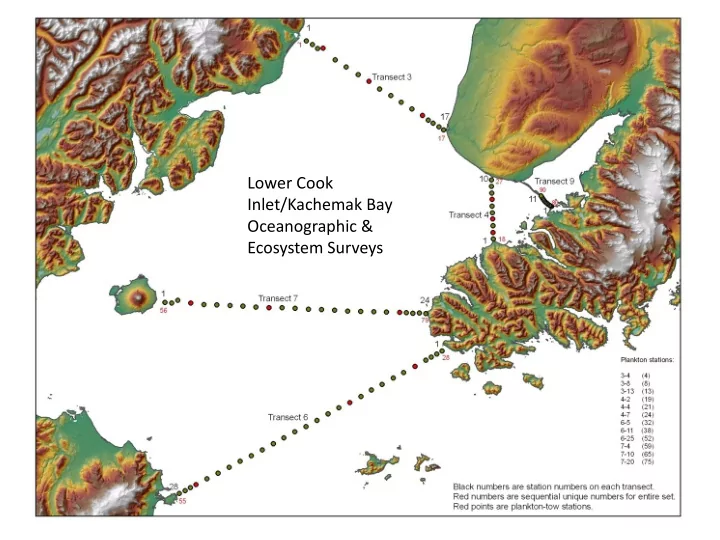

Lower Cook Inlet/Kachemak Bay Oceanographic & Ecosystem Surveys
Kachemak Bay Water Temperature from KBRR long-term SWMP station in Seldovia
Salinity (PSU) 29.5 30 30.5 31 31.5 32 CTD Data Examples 0 10 25 June 2012 20 30 Depth (m) 40 Salinity (PSU) 50 Middle of Spit Line 60 70 80 90 100 5 6 7 8 9 10 11 Temperature ( C) Tutka Bay
Kasitsna Bay Lab 2012 Phytoplankton Monitoring Alexandrium spp. Courtesy: Charlayna Cammarata NOAA Hollings scholar
Monitoring Temporal and Spatial Trends in Lower Cook Inlet and Kachemak Bay Waters to Inform Understanding of Ecological Processes
The Big Idea Primary Goal: The primary goal is to continue monitoring long-term data trends in plankton and sea water attributes which link the outer Gulf of Alaska with the inshore waters in Kachemak Bay and relate these patterns to primary productivity. – This project is linked to 26 other major studies of the ecosystem in the Gulf of Alaska, Kenai Peninsula and Prince William Sound
Background Information The Kachemak Bay Research Reserve is studying trends in ocean temperature, conductivity, dissolved oxygen, pH, turbidity, and chlorophyll fluorescence in the NERR water quality monitoring program at three sites in Kachemak Bay. Measurements at these fixed locations are augmented spatially by replicating CTD transects across the Bay (2 transects) and in lower Cook Inlet (3 transects)
Kachemak Bay and Lower Cook Inlet CTD/Plankton Sampling Sites
Euphausid Arrow worm Sea Polychaete larve Tunicate larve Polychaete 7% 0% butterfly 0% Copepod Station25 1% 0% Bivalve 1% Sea butterfly Bivalve 0% Crustaean larve 0% 7% Evadne 0% 1% 0% Barnacle larve Copepod Copepod 7% 17% 25% Crustaean larve Polychaete 6% Copepod larve 1% Copepod 23% Unk Egg 11% 14% Copepod Copepod 25% Copepod Copepod 6% 11% Copepod 0% Arrow worm Copepod 1% 13% 1% Unk Egg Tunicate Station5 Copepod 9% larve 0% 0% Crustaean Barnacle Crustaean Copepod Tunicate larve Arrow larve Polychaete Euphausid Evadne larve larve 0% Crustaean larve Polychaete Polychaete 0% worm 1% 2% 2% 0% 1% 8% 0% larve 0% 0% Euphausid 0% 7% Evadne 3% Copepod Barnacle larve 16% 8% Copepod Crustaean larve 26% 33% Copepod 1% Copepod Unk Egg Copepod Copepod 0% Station11 0% 1% 3%
Sea butterfly Polychaete Copepod Hydrozoan Copepod Tunicate Hydriods Amphipod Euphausid Copepod Gammarid Echinoderm Fritillaria Sea Copepod Clam 0% 1% larve 0% larve 0% 0% Isopod 2% Bivalve 0% 0% Trochozoan Crustacea amphipod Arrow worm Hydriods Hydriods Gadid larvae Hydrozoan Hydrozoan borealis larve Copepod butterfly 2% larvae Polychaete Bivalve 1% 0% 0% Bryozoan Copepod 0% 4% 0% 0% 0% 0% 1% Shrimp 0% 0% 0% 0% 5% 0% 2% 1% 0% Crab zoea 0% 0% 0% Copepod Copepod zoea Unk fish egg 4% Arrow Copepod 0% 2% 4% Polychaete 4% 1% worm Copepod Copepod Copepod Copepod 3% 1% 8% 0% 0% 0% Unk fish egg Copepod Unk zoea Copepod 1% 19% 1% Barnacle 0% Copepod nauplii Copepod 1% Unk Nauplii 11% 0% Copepod 0% 0% Barnacle nauplii Unk Egg 27% Copepod 27% 0% Copepod Unk Egg 0% 63% Unk Nauplii Zooplankton Transect 9 Station 1 1% Zooplankton Transect 9 Station 10 Crab Gammarid Polychaete Copepod Clam Arrow Polychaete Hydrozoan Shrimp zoea amphipod larve larvae 6% worm Bivalve 1% 1% zoea 1% 0% 0% 0% 1% 1% Copepod 0% Copepod Echinoderm Copepod 2% 0% Sea butterfly larve 2% 6% 0% Copepod 0% Fish Egg 5% Copepod 0% Barnacle nauplii Unk Egg 27% 45% Unk Nauplii 1% Zooplankton Transence 9 Station 6
U.S. Fish and Wildlife Service, Migratory Bird Management At Sea Observer Program. Maps provided by L. Labunski and K. Kuletz
U.S. Fish and Wildlife Service, Migratory Bird Management At Sea Observer Program. Maps provided by L. Labunski and K. Kuletz
Steps Along the Way • Develop a library of common plankton species for the region • Refine plankton sampling locations based on CTD sampling • Assess the temporal patterns for plankton blooms in Kachemak Bay and lower Cook Inlet
Recommend
More recommend